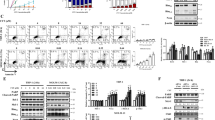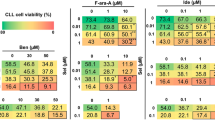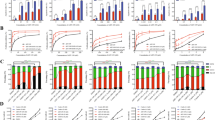Abstract
Chemotherapy remains mainly used for the treatment of acute myeloid leukemia (AML). However, in the past 3 decades limited progress has been achieved in improving the long-term disease-free survival. Therefore the development of more effective drugs for AML represents a high level of priority. F14512 combines an epipodophyllotoxin core targeting topoisomerase II with a spermine moiety introduced as a cell delivery vector. The polyamine moiety facilitates F14512 selective uptake by tumour cells via the polyamine transport system, a machinery overactivated in cancer cells. F14512 has been characterized as a potent drug candidate and is currently in Phase I clinical trials. Here, we demonstrated marked survival benefit and therapeutic efficacy of F14512 treatments in a series of human AML models, established either from AML cell lines or from patient AML samples. Furthermore, we reported in vitro synergistic anti-leukemic effects of F14512 in combination with cytosine arabinoside (Ara-C), doxorubicin, gemcitabine, bortezomib or SAHA. In vivo combination of suboptimal doses of F14512 with Ara-C also resulted in enhanced anti-leukemic activity. We further showed that F14512 triggered both senescence and apoptosis in vivo in primary AML models, but not autophagy. Overall, these results support the clinical development in onco-hematology of this novel promising drug candidate.
This is a preview of subscription content, access via your institution
Access options
Subscribe to this journal
Receive 12 print issues and online access
$259.00 per year
only $21.58 per issue
Buy this article
- Purchase on Springer Link
- Instant access to full article PDF
Prices may be subject to local taxes which are calculated during checkout







Similar content being viewed by others
References
Lowenberg B, Downing JR, Burnett A . Acute myeloid leukemia. N Eng J Med 1999; 341: 1051–1062.
Deschler B, Lubbert M . Acute myeloid leukemia: epidemiology and etiology. Cancer 2006; 107: 2099–2107.
Kern W, Estey EH . High-dose cytosine arabinoside in the treatment of acute myeloid leukemia: review of three randomized trials. Cancer 2006; 107: 116–124.
Appelbaum FR, Gundacker H, Head DR, Slovak ML, Willman CL, Godwin JE et al. Age and acute myeloid leukemia. Blood 2006; 107: 3481–3485.
Kantarjian H, O’Brien S, Cortes J, Giles F, Faderl S, Jabbour E et al. Results of intensive chemotherapy in 998 patients age 65 years or older with acute myeloid leukemia or high-risk myelodysplastic syndrome: predicitive prognostic models for outcome. Cancer 2006; 106: 1090–1098.
Adema AD, Smid K, Losekoot N, Honeywell RJ, Verheul HM, Myhren F et al. Metabolism and accumulation of the lipophilic deoxynucleoside analogs elacytarabine and CP-4126. Invest New Drugs 2012; 30: 1908–1916.
Kean N, Freeman C, Swords R, Giles FJ . Elacytarabine: lipid vector technology under investigation in acute myeloid leukemia. Expert Rev Hamatol 2013; 6: 9–24.
Annereau JP, Brel V, Dumontet C, Guminski Y, Imbert T, Broussas M et al. A fluorescent biomarker of the polyamine transport system to select patients with AML for F14512 treatment. Leuk Res 2010; 34: 1383–1389.
Ballot C, Jendoubi M, Kluza J, Jonneaux A, Laine W, Formstecher P et al. Regulation by survivin of cancer cell death induced by F14512, a polyamine-containing inhibitor of DNA topoisomerase II. Apoptosis 2012; 17: 364–376.
Barret JM, Kruczynski A, Vispé S, Annereau JP, Brel V, Guminski Y et al. F14512, a potent antitumor agent targeting topoisomerase II vectored into cancer cells via the polyamine transport system. Cancer Res 2008; 68: 9845–9853.
Brel V, Annereau JP, Vispé S, Kruczynski A, Bailly B, Guilbaud N . Cytotoxicity and cell death mechanisms induced by the polyamine-vectorized anti-cancer drug F14512 targeting topoisomerase II. Biochem Pharmacol 2011; 82: 1843–1852.
Gentry AC, Pitts SL, Jablonsky MJ, Bailly C, Graves DE, Osheroff N . Interactions between the etoposide derivative F14512 and human type II topoisomerases: implications for the C4 spermine moiety in promoting enzyme-mediated DNA cleavage. Biochemistry 2011; 50: 3240–3249.
Kruczynski A, Vandenberghe I, Pillon A, Pesnel S, Goetsch L, Barret JM et al. Preclinical activity of F14512, designed to target tumors expressing an active polyamine transport system. Invest New Drugs 2011; 29: 9–21.
Chelouah S, Monod-Wissler C, Bailly C, Barret JM, Guilbaud N, Vispé S et al. An integrated Drosophilia model system reveals unique properties for F14512, a novel polyamine-containing anticancer drug that targets topoisomerase II. PLoS One 2011; 6: e23597.
De Botton S, Berthon C, Bulabois CE, Prebet T, Vey N, Chevallier P et al. F14512 a novel polyamine-vectorized anti-cancer drug targeting topoisomerase II in adults patients with acute myeloid leukemia (AML): results from a Phase 1 study. EHA 17th Congress, 14–17 June 2012; Amsterdam.
Créancier L, Pillon A, Verdier J, Chansard N, Pourtau S, Vandenberghe I et al. Use of bioluminescence imaging and quantitative RT-PCR to monitor tumor progression and treatment response in orthotopic AML mouse models: Application to the targeted cytotoxic agent F14512. Eur J Cancer 2010; 8: 89.
Kruczynski A, Colpaert F, Tarayre J-P, Mouillard P, Fahy J, Hill BT . Preclinical in vivo antitumour activity of vinflunine, a novel fluorinated Vinca alkaloid. Cancer Chemother Pharmacol 1998; 41: 437–447.
Plovins A, Alvarez AM, Ibanez M, Molina M, Nombela C . Use of fluorescein-dibeta-D galactopyranoside (FDG) and C12-FDG as substrates for beta-galactosidase detection by flow cytometry in animal, bacterial, and yeast cells. Appl Environ Microbiol 1994; 60: 4638–4641.
Chou TC . Theoretical basis, experimental design, and computerized simulation of synergism and antagonism in drug combination studies. Pharmacol Rev 2006; 58: 621–681.
Corbett TH, Veleriote FA, Demchik L, Polin L, Panchapor C, Pugh S et al. Preclinical anticancer activity of cryptophycin-8. J Exp Ther Oncol 1996; 1: 95–108.
Scatena CD, Kumer JL, Arbitrario JP, Howlett AR, Hawtin RE, Fox JA et al. Voreloxin, a first-in-class anticancer quinolone derivative, acts synergistically with cytarabine in vitro and induces bone marrow aplasia in vivo. Cancer Chemother Pharmacol 2010; 66: 881–888.
Nakao M, Yokota S, Iwai T, Kaneko H, Horiike S, Kashima K et al. Internal tendem duplication of the flt3 gene found in acute myeloid leukemia. Leukemia 1996; 10: 1911–1918.
Renneville A, Roumier C, Biggio V, Nibourel O, Boissel N, Fenaux P et al. Cooperating gene mutation in acute myeloid leukemia: a review of the literature. Leukemia 2008; 22: 915–931.
Chresta CM, Hicks R, Hartley JA, Souhami RL . Potentiation of etoposide-induced cytotoxicity and DNA damage in CCRF-CEM cells by pretreatment with non-cytotoxix concentrations of arabinosyl cytosine. Cancer Chemother Pharmacol 1992; 31: 139–145.
Lin TL, Levy MY . Acute myeloid leukemia: focus on novel therapeutic strategies. Clin Med Insights 2012; 6: 205–217.
Shay JW, Roninson IB . Hallmarks of senescence in carcinogenesis and cancer therapy. Oncogene 2004; 23: 2919–2933.
Chang BD, Broude EV, Dokmanovic M, Zhu H, Ruth A, Xuan Y et al. A senescence-like phenotype distinguishes tumor cells that undergo terminal proliferation arrest after exposure to anticancer agents. Cancer Res 1999; 59: 3761–3767.
Chiu CC, Li CH, Ung MW, Fuh TS, Cheng WL, Fang K . Etoposide (VP-16) elicits apoptosis following prolonged G2-M arrest in p53-mutated human non-small cell lung cancer cells. Cancer Lett 2005; 223: 249–258.
Mow BMF, Blajeski AL, Chandra J, Kaufmann SH . Apoptosis and the response to anticancer therapy. Curr Opin Oncol 2001; 13: 453–462.
te Poele RH, Okorokov AL, Jardine L, Cummings J, Joel SP . DNA damage is able to induce senescence in tumor cells in vitro and in vivo. Cancer Res 2002; 62: 1876–1883.
Campisi J, d’Adda di Fagagna F . Cellular senescence: when bad things happen to good cells. Nat Rev Mol Cell Biol 2007; 8: 729–740.
Lin CI, Whang EE, Lorch JH, Ruan DT . Autophagic activation potentiates the antiproliferative effects of tyrosine kinase inhibitors in medullary thyroid cancer. Surgery 2012; 152: 1142–1149.
Knizhnik AV, Roos WP, Nikolova T, Quiros S, Tomaszowski KH, Christmann M et al. Survival and death strategies in glioma cells: autophagy, senescence and apoptosis triggered by a single type of temozolomide-induced DNA damage. PLoS One 2013; 8: e55665.
Oke A, Pearce D, Wilkinson RW, Crafter C, Odedra R, Cavenagh J et al. AZD1152 rapidly and negatively affects the growth and survival of human acute myeloid leukemia cells in vitro and in vivo. Cancer Res 2009; 69: 4150–4158.
Acknowledgements
The authors gratefully acknowledge Dr Christian Recher and Cécile Demur for the selection of AML patient samples, as well as Dr Alain Latil for his scientific contribution to this work. We also thank Nathalie Chansard, Sandrine Pourtau, Valérie Cartron, Sabine Roy, Jean-Christophe Blanchet, Jérôme Verdier, Marie-Laure Marionnaud, Karine André, Vanessa Offrete and Stéphane Gras for their skilled technical assistance and Christel Ricome for its valuable data-processing assistance.
Author information
Authors and Affiliations
Corresponding author
Ethics declarations
Competing interests
The authors declare no conflict of interest.
Rights and permissions
About this article
Cite this article
Kruczynski, A., Pillon, A., Créancier, L. et al. F14512, a polyamine-vectorized anti-cancer drug, currently in clinical trials exhibits a marked preclinical anti-leukemic activity. Leukemia 27, 2139–2148 (2013). https://doi.org/10.1038/leu.2013.108
Received:
Revised:
Accepted:
Published:
Issue Date:
DOI: https://doi.org/10.1038/leu.2013.108
Keywords
This article is cited by
-
Activity of the polyamine-vectorized anti-cancer drug F14512 against pediatric glioma and neuroblastoma cell lines.
Investigational New Drugs (2014)



